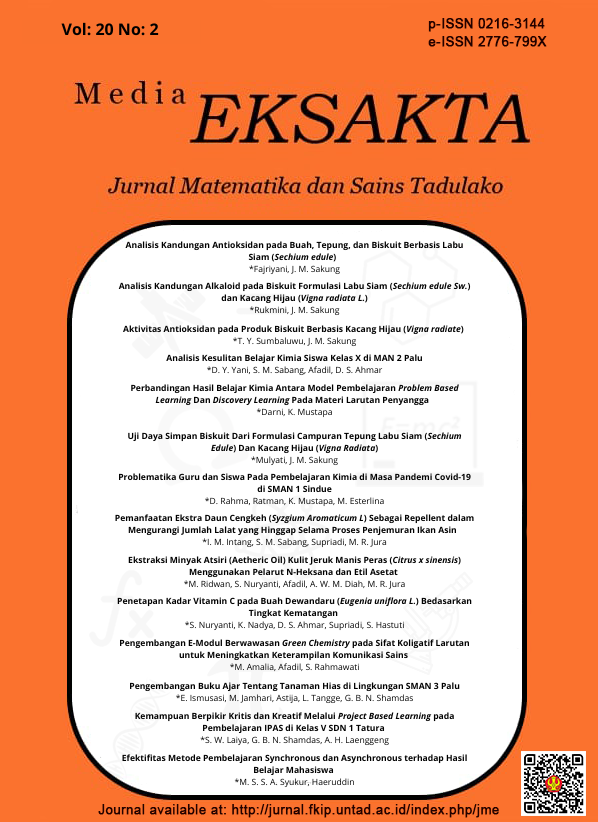Effectiveness Effectiveness of Synchronous and Asynchronous Learning Methods on Student Learning Outcomes
Keywords:
Synchronous learning, Asynchronous learning, Learning outcomes, Computer application courseAbstract
This study aims to determine the effect of synchronous and asynchronous learning on student learning outcomes in computer application courses. The population in this study were students of the Indonesian Language and Literature Education study program at Tadulako University. Sampling was done by purposive sampling technique so that 2 classes were obtained that were normally distributed and homogeneous. This research uses a quantitative approach with a quasi-experimental method. Data analysis used one sample t test with the help of jamovi application. The results showed that synchronous and asynchronous learning can improve student learning outcomes in computer application courses with an average value of 84.9 in the experimental class and 83.6 in the control class. The prerequisite test results obtained p value (0.263) >0.05 in the normality test (Shapiro-Wilk) shows that the data distribution is normally distributed, and the p value (0.889) >0.05 in the homogeneity test (Levane's) shows that the variance of the two data groups is homogeneous. The results of hypothesis testing using independent samples t-test obtained p (0.021) > α (0.05), so Ho is accepted, indicating that there is no significant difference in the average test scores between synchronous and asynchronous learning.
References
Herman Tobo, Arnindia Putri, and Astriana Harjanti, “CSRRP News,” Mar. 2024. Accessed: Jun. 14, 2024. [Online]. Available: https://sitaba.net/storage/upload/dokumen/file/Newsletter_CSRRP-Edisi-Maret-2024.pdf
S. F. Persada et al., “How the Education Industries React to Synchronous and Asynchronous Learning in COVID-19: Multigroup Analysis Insights for Future Online Education,” Sustainability, vol. 14, no. 22, p. 15288, Nov. 2022, doi: 10.3390/su142215288.
D. G. Hendra Divayana, “ANEKA-based Asynchronous and Synchronous Learning Design and its Evaluation as Efforts for Improving Cognitive Ability and Positive Character of Students,” International Journal of Modern Education and Computer Science, vol. 13, no. 5, pp. 14–22, Oct. 2021, doi: 10.5815/ijmecs.2021.05.02.
E. Purwandari and A. H. Prasetyo, “Students’ perceptions of online learning based on synchronous and asynchronous learning,” 2023, p. 160004. doi: 10.1063/5.0170881.
M. R. A. Pratama, M. K. Dewi, and E. Susilowati, “Integrating Camtasia, YouTube, and Google Classroom to create asynchronous learning environments,” World Journal on Educational Technology: Current Issues, vol. 14, no. 5, pp. 1549–1563, Sep. 2022, doi: 10.18844/wjet.v14i5.7671.
M. H. Fahmi, “Komunikasi Synchronous dan Asynchronous dalam e-Learning pada Masa Pandemic Covid-19,” Jurnal Nomosleca, vol. 6, no. 2, Oct. 2020, doi: 10.26905/nomosleca.v6i2.4947.
B. N. Bunga, A. A. Adu, Y. Damayanti, T. Takalapeta, S. Ch. Pello, and I. Y. Kiling, “Synchronous vs. Asynchronous: Photovoice Study on Indonesian Youth’s Online Learning Experience,” Child Youth Serv, vol. 43, no. 3, pp. 276–289, Jul. 2022, doi: 10.1080/0145935X.2021.1901572.
M. S. S. A. Syukur, “Jurpis: Jurnal Pendidikan Ilmu Sosial Studi Deskriptif Perilaku Penggunaan Internet di kalangan Mahasiswa Fakultas Keguruan dan Ilmu Pendidikan Universitas Tadulako,” 2021.
Ulinsa, S. Harisah, A. Karim, I. Nuraeini, G. Lembah, and M. Tahir, “Kurikulum Program Studi Pendidikan Bahasa dan Sastra Indonesia,” 2022.
Haeruddin and Muh. S. S. A. Syukur, “Rencana Pembelajaran Semester Mata Kuliah Aplikasi Komputer,” 2023.
Sugiyono, Metode Penelitian Kuantitatif Kualitatif dan R&D. Bandung: Alfabeta, 2019.
The Jamovi Project, “Jamovi (Version 2.3),” 2022, https://www.jamovi.org.
R Core Team, “R: A Language and Environment for Statistical Computing (Version 4.1),” 2021, https://cran.r-project.org.
A. Y. Wardana, A. A. Fitri, H. Z. Lunggana, K. N. Kusuma, M. Fathurrachman, and N. N. Insani, “Analisis pembelajaran Synchronous dan Asynchronous dalam meningkatkan Civic Competence di Sekolah,” Nautical: Jurnal Ilmiah Multidisiplin Indonesia, vol. 2, no. 2, pp. 78–87, 2023.
Downloads
Published
How to Cite
License
Copyright (c) 2024 Muh. Syarif S. Abd. Syukur, Haeruddin

This work is licensed under a Creative Commons Attribution-ShareAlike 4.0 International License.
Authors who publish with Jurnal Media Eksakta agree to the following terms:
- Authors retain copyright and grant the journal right of first publication with the work simultaneously licensed under a Creative Commons Attribution License (CC BY-SA 4.0) that allows others to share the work with an acknowledgment of the work's authorship and initial publication in this journal.
- Authors are able to enter into separate, additional contractual arrangements for the non-exclusive distribution of the journal's published version of the work (e.g., post it to an institutional repository or publish it in a book), with an acknowledgment of its initial publication in this journal.
- Authors are permitted and encouraged to post their work online (e.g., in institutional repositories or on their website) prior to and during the submission process, as it can lead to productive exchanges, as well as earlier and greater citation of published work.




